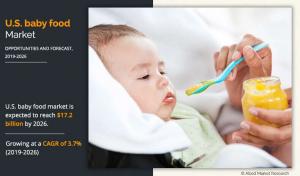Mexico - Floridas News originally published at Mexico - Floridas News
— Allied Market Research
WILMINGTON, NEW CASTLE, DELAWARE 19801 USA, UNITED STATE, November 22, 2023 /EINPresswire.com/ — According to a new report published by Allied Market Research, titled ” U.S. Baby Food Market by Product Type and Distribution Channel: Opportunity Analysis and Industry Forecast, 2019-2026 ” the U.S. baby food market size was valued at $12.9 billion in 2018 and is projected to reach $17.2 billion by 2026, growing at a CAGR of 3.7% from 2019 to 2026. The cereal segment was the highest contributor in the market and accounted for approximately 40% of the total market share in 2018.
Request Sample Copy of This Report @ https://www.alliedmarketresearch.com/request-sample/6212
Rise in private label baby food, increase in demand for packaged baby food, urbanization paired with a significant increase in the working women population, and surge in demand for direct to consumer baby foods are the major drivers of the U.S. baby food market. After the Great Recession, consumer spending on household products experienced a decline. This behavior also impacted the purchasing pattern for baby food products in the U.S. The demand for private label baby products thus experienced a boost since they offer baby food products at a lower range as compared to national brands.
Get Report Customization @ https://www.alliedmarketresearch.com/request-for-customization/6212
In addition, the concept of direct to consumer baby food products gained traction. Meal-kit delivery services of packaged baby food has attained popularity owing to its quality of food and door-step delivery service. Furthermore, attractive, eco-friendly and sustainable packaging of products has enabled brands to create a positive impact on their target customers. Consumers have gradually become conscious regarding the contribution they make toward the environment and are hence adopting products with sustainable packaging. For instance, the brand Once Upon a Farm uses materials for pouches that require fewer raw materials and less energy to produce as compared to a typical glass jar, which enables them to reduce the size of our carbon footprint. Thus, producers can relate to the target consumers and thereby influence their buying decisions. These factors have fueled the U.S. baby food market growth.
Talk to our Analyst @ https://www.alliedmarketresearch.com/connect-to-analyst/6212
However, the rise in incidence of fertility disorders among female population and lower success rate of artificial fertility treatment had decreased the overall number of pregnancies in the U.S. Fertility rate in the U.S. has reached to the lowest level in 32 years. This is expected to hamper the growth of the U.S. baby food market during the forecast period.
The U.S. baby food market analysis is based on product type and distribution channel. Based on product type, the market is classified into prepared baby food, dried baby food, cereal, and other baby food. Based on distribution channel, the market is bifurcated into hypermarket & supermarket, independent grocery store, specialty store, direct to consumer, and online store.
Make a Direct Purchase @ https://www.alliedmarketresearch.com/checkout-final/e49793426a695b8f1a2fa038e669c37c
Key Findings of the U.S. Baby Food Market:
Based on type, the cereal segment accounts for the largest share in the baby food market in 2019, however the other baby food segment is expected to grow at the fastest CAGR of 6.2% during the U.S. baby food market forecast period.
Based on distribution channel, the hypermarket & supermarket segment accounts for the larger U.S. baby food market share in 2019, while the direct to consumer segment is expected to experience growth at the fastest CAGR of 10.8% during the forecast period.
The key players in the US baby food industry include Abbott laboratories, Beech Nut, Danone, Diana Group, The Hain Celestial Group, Inc., The Kraft Heinz Company, Little Spoon Inc., Mead Johnson & Company, LLC., Nestlé S.A., and Plum, PBC.
Browse More Related Reports:
Global Animal Feed Additives Market– https://www.globenewswire.com/en/news-release/2019/10/24/1935039/0/en/Global-Animal-Feed-Additives-Market-Is-Expected-to-Reach-31-38-Bn-by-2025-Says-AMR.html
Global food traceability market– https://www.globenewswire.com/news-release/2019/04/04/1797104/0/en/Global-food-traceability-market-is-expected-to-garner-22-27-billion-by-2025-AMR.html
David Correa
Allied Analytics LLP
+ + +1 800-792-5285
email us here
Visit us on social media:
Facebook
Twitter
LinkedIn
![]()
Originally published at https://www.einpresswire.com/article/670211538/usa-dominated-the-u-s-baby-food-market-with-cagr-of-3-7-17-2-billion-and-forecast-up-to-2026
The post USA Dominated the U.S. Baby Food Market with CAGR of 3.7% first appeared on Floridas News.
Mexico - Floridas News originally published at Mexico - Floridas News

